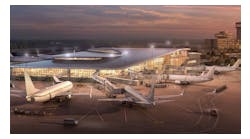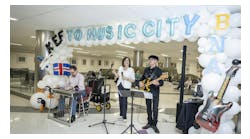Syracuse, N.Y. — The Federal Aviation Administration is prohibiting planes from landing at Syracuse Hancock International Airport in low-visibility conditions because of worries that new 5G cellular signals will interfere with radio altimeters on some aircraft.
In a statement Wednesday morning, the Syracuse Regional Airport Authority, which operates the airport, said Hancock is on a list of several airports where “low visibility operations are not permitted to occur due to the rollout of 5G cellular service today.”
It said low visibility is defined as less than a 200-foot ceiling and less than 1,800 feet ‘runway visual range’ — a measure of how far down the runway a pilot can see runway surface markings.
The authority said it could not comment further until it receives “further information and guidance” from the FAA.
“While information is limited at this time, we will continue to engage with our federal partners and airline partners to ensure safe and efficient aircraft operations at the airport as the complications associated with 5G are worked out,” it said.
The airport’s website showed no flight cancelations at Hancock Wednesday morning.
5G, or fifth generation wireless service, promises faster speeds on cell phones and other wireless devices than is possible with older cellular standards. However, the FAA says 5G networks use radio frequencies that can be close to those used by radar altimeters, an important piece of safety equipment that allows planes to measure altitude above the terrain.
Pilots use the measurement to monitor their altitude while they are landing. It is especially useful to them when they are landing in low-visibility conditions, such as rain or fog.
In a statement on its website, the FAA said it will need to impose restrictions on flight operations using certain types of radar altimeter equipment close to antennas in 5G networks.
“These safety restrictions could affect flight schedules and operations, affecting the aviation system,” the FAA said. “Before and after the 5G deployment begins, the FAA will continue to work every day to reduce effects of this disruption as we make progress to safely integrate 5G and aviation.”
It said some altimeters are “reliable and accurate” in areas with 5G, while others must be retrofitted or replaced.
Wireless carriers have said 5G has been safely deployed in more than 40 other countries without disrupting aviation services.
Nevertheless, telecommunications carriers voluntarily delayed 5G deployment by two weeks and agreed to restrict their own antenna operations in areas close to key airports where the FAA said interference could lead to significant disruptions. The FAA, working with the carriers, established 5G “buffer zones” around 50 airports, including Hancock, with wireless transmitters in close proximity to the runways.
With the two-week delay now over, the FAA is now imposing low-visibility landing restrictions at some of those airports, including at Syracuse.
On Sunday, the FAA cleared an estimated 45 percent of the U.S. commercial fleet to perform low-visibility landings at many of the airports where 5G was to be deployed today. The agency also said it approved two radio altimeter models that are installed in a wide variety of Boeing and Airbus planes.
“This combination of aircraft and altimeter approval opens up runways at as many as 48 of the 88 airports most directly affected by 5G C-band interference,” it said.
However, even with the new approvals, flights at some airports may still be affected, according to the FAA.
“Passengers should check with their airlines if weather is forecast at a destination where 5G interference is possible,” it said.
The Airports Council International - North America, which represents commercial airports in the U.S. and Canada, has been critical of the federal government for not working out solutions to aviation industry concerns about 5G earlier.
“Potential interference of new 5G services with well-established radar altimeter frequencies have been known for years,” Kevin M. Burke, president and CEO, of the council, said in a letter to the FAA and Federal Communications Commission on Thursday. “Ample time was available to develop reasonable near and long-term solutions that would avoid impacts to travelers, air cargo shippers, and communities that depend on reliable air transportation services.”
Rick Moriarty covers business news and consumer issues. Got a tip, comment or story idea? Contact him anytime: Email | Twitter | Facebook | 315-470-3148
©2022 Advance Local Media LLC. Visit syracuse.com. Distributed by Tribune Content Agency, LLC.



